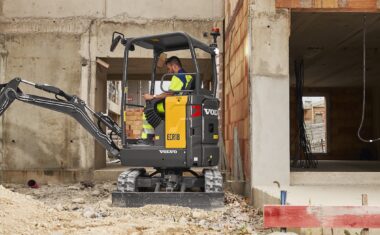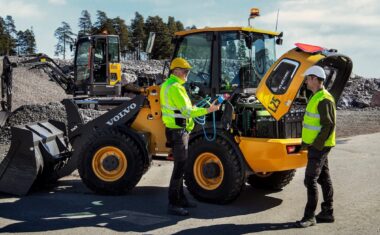While there’s an increase of electric heavy equipment in the construction market, the uptick in servicing these machines likely won’t be felt for some time yet. That’s because electric machines don’t require as much maintenance — nor as often — as similar diesel models. Plus, they’re still relatively new.
The servicing of electric construction equipment, however, will eventually pick up — it’ll likely follow the trend already seen with electric cars, buses, trucks and other more common on-road electric vehicles (EVs). So, if you run a heavy equipment service department, sooner rather than later you should begin to prepare your techs and shop environment for properly — and safely — servicing and maintaining electric construction equipment.
If your organization sells electric construction equipment, the manufacturer should provide information and training on proper maintenance and service. If you’re an independent servicer, we strongly recommend that you receive the proper training by the manufacturer prior to performing any service or maintenance work.
Here are the standard roles we use for servicing Volvo EVs and electric construction equipment (all types including heavy equipment, buses, trucks, etc.) and three steps to help get you started.
Identify work roles. It’s important to know who will be in charge of what, and which roles can and cannot work on electric machines. When it comes to servicing electric construction equipment, safety should always be your #1 priority, and with the proper roles identified, you set yourself up for a much safer work environment.
To give you an idea of the types of roles to identify:
Overall Electric Responsible (Level 1): This is the individual who has signed up and agreed to sell and/or service electric machines, typically someone in upper management.
Skilled Person (Level 2): These individuals are subject matter experts, engineering trainers and technical writers on the process team who write procedures. These individuals typically work for the EV manufacturer (e.g. Volvo).
Electric Product Responsible (Level 3): This is essentially the service manager who oversees the department, plans and leads risk assessments, ensures the right people have received the appropriate training and certifications for electrical work and so on. This role delegates which tech or techs will become Level 4 certified.
Work Activity Responsible (Level 4): This is the technician responsible for working on electric machines. They’re the only ones allowed to decommission and commission machines to ensure they’re safe for them or others to work on. In the beginning, you may only have one person in this role, but as more electric machines come in for service, this role may expand to two or even three individuals.
Instructed Technician (Level 5): This role includes any other non-Level 4 certified technicians in your shop that can help work on machines (e.g. change out parts) once the machines are decommissioned and deemed safe to work on. These techs typically work to become a Level 4 down the road once they’re certified.

I’m going to continue to reference these levels in the blog. I know you may not use this same terminology for classifying roles, but the main point I want to get across here is the importance of having a hierarchical process like this.
How does this hierarchy work? As an example, let’s say your Level 4 service tech has a question on a process and isn’t sure how to safely move forward. They should not simply make a decision and go with it. The tech would contact their manager who would then contact a skilled person on the OEM level. The skilled person (e.g. an electrical engineer) would then take a look at the issue and work with the process team that writes the procedures to rewrite the procedure and send it back out to the Level 4 technician to properly and safely move forward.
It’s important to remember that your techs should never improvise while servicing electric equipment — that’s how someone might get seriously injured or killed. Your trained and certified Level 4 technician(s) are there to help ensure electric machines are safe to work on and can then test and inspect the work of others afterward to ensure everything was done correctly.
Purchase the proper tools for your Level 4 techs. Many service departments will have a lot of the tools listed below — but if you don’t, it’s important to invest in the right tools to help ensure your Level 4 techs stay safe when electric machines are in your shop. Many of the items listed below can be purchased online or at a local hardware store.
Here are the tools that can help streamline service and create a safer environment for Level 4 techs while working on electric heavy equipment:
Rolling Pack Out: This is optional, but a rolling pack out tool organizer is a great way to keep all your tools in one place. You should always have your electric vehicle tools separate from the rest of your tools so they’re easy to access and find.
Silicone Ties (Cable Straps): These are used for hanging the machine safety card in the cab listing the service manager, Level 4 tech and safety contact number. They can also be used to tie up disconnected wires to keep them out of the way when working on the machine or changing out a component.
Blanket Clamps – Pair (Qty 3): Used along with the 1,000 V rubber mat to keep the wrap tight around the traction battery cables when decommissioning.
“Danger – High Voltage, Electrical Shock Hazard” Signs: I recommend a minimum of four signs to hang with the safety chains around the machine. 10″ x 14″ is a good size.

Plastic, 14″ X 10″ Restricted Area Signs, plus Safety Chain Barriers: These signs say “Unauthorized Persons Keep Out” to define a restricted area. If your shop doesn’t have a dedicated bay, all electric machines in service must be surrounded by chains and barriers with these signs 3 feet from the machine. This creates a 3-ft work zone for your Level 4 tech (and Level 5 techs once a machine is decommissioned). Tools should be kept outside of this work zone when you’re not using them. And remember, depending on where you’re located here in North America, you may need either Spanish or French versions in addition to your English signs.
8-Inch Black Zip Ties (1,000 Pack): These are used to hang your “Danger – High Voltage” and restricted area signs.
Electrical Lockout Tagout Kit: These devices safeguard your techs from hazardous energy releases while performing maintenance or servicing electric equipment.
1,000 V Insulated Rubber Mat (Qty 4): I recommend 40″ x 40″. You need to ensure they’re rated for a minimum of 1,000 volts because when you decommission a machine, you use the rubber matting to wrap up the positive (red) and negative (black) traction battery cables off the battery packs with the blanket clamps.
1,000 V Insulated Work Gloves: These are used to protect the Level 4 tech when decommissioning and commissioning electric machines.
5-Inch Flush Wire Cutters: Small snips are important when cutting the zip ties off the battery traction cables. You don’t want to cut into the wires because if you damage one, then they all must be replaced together.
1,000 V Insulated Screwdriver Set: These should be used to remove screws on any cover or component with the yellow high voltage decal on it.
1,000 V Graded Face Shield: This is used to protect the Level 4 tech when decommissioning and commissioning electric machines.
High-Voltage Isolation Battery Terminal Caps (Rubber or Plastic): These are used in case of any unexpected spark or hazard while disconnecting batteries.
Voltmeter (DUSPOL) 1000 V (88830641): For Volvo EVs, this is the only voltmeter allowed to decommission a vehicle or machine. That’s because there’s no power in it — it only takes power sources, meaning it doesn’t have an internal power source that could cause any problems when a tech is testing a machine to decommission it.
Insulation Tester: These are used to verify work performed on the machine and to test and confirm traction voltage cables are within specification for safe machine use.
Amp Clamps: These are used to safely test current flows through any traction voltage lines/cables on the machines.
1000 V Cat. III or Higher Multimeter: These are used with the amp clamps to safely test current flows through any traction voltage lines/cables on the machine. This meter should be a known name brand model to ensure accurate readings. Basically, don’t go cheap here or someone might get hurt.
This may all sound like a lot, but like I said, it’s similar to the tools and procedures already in place for servicing on-road EVs like electric cars, buses and trucks, plus electric equipment that has been out for a while longer like forklifts, scissor lifts and so on.
Keep safety devices nearby. Your shop should also be equipped with safety devices like a defibrillator (shown below) in case you need to restore a normal heartbeat, and a safety pole (e.g. long wooden pole) to remove someone from an electrical source. These would be in addition to any other safety devices or kits you have on site.
It’s also a good idea to contact your local emergency services (fire, ambulance, etc.) to come out and walk through your site and do an inspection. They can work with you to ensure any local requirements are covered as well. Please keep in mind OSHA workplace requirements too.
Servicing a wider range of electric heavy equipment is coming. Those who are properly set up and have technicians certified to work on these machines down the road will give themselves greater opportunity for increased income and repeat business.
Doing it the right way — safely — is your first start. If you have additional questions about servicing electric heavy equipment, feel free to leave us a comment below and we’ll get back to you.
By Mike Cordell

Why You May Need to Rethink Machine Work Hours with Electric Equipment
The construction industry continues to integrate electric equipment into fleets, as they’re promising alternatives to their diesel-powered counterparts. The reason they’re becoming more popular options is because electric heavy equipment offers numerous advantages including lower …
09/12/2023

How to Maintain Electric Heavy Equipment
How different is it to maintain electric construction equipment versus diesel construction equipment? The short answer is that with electric, it’s much simpler — hardly any maintenance is needed at all on the electric components …
12/12/2022
>>> Read full article>>>
Copyright for syndicated content belongs to the linked Source : VolvoCEBlog – https://volvoceblog.com/is-your-business-ready-to-service-electric-construction-equipment/






























